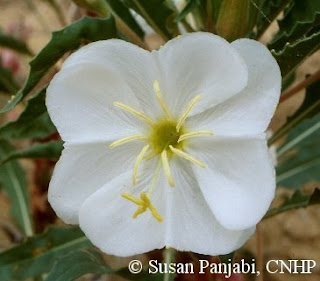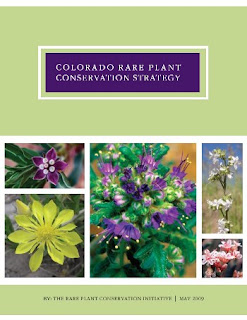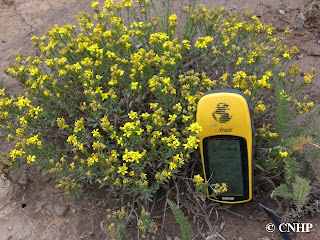By Peggy Lyon and Jill Handwerk, CNHP Botanists
CNHP worked with Colorado State Parks to collect detailed baseline information on rare and imperiled plants and plant communities found at the new Lone Mesa State Park, in southwestern Colorado.
Work included detailed mapping of imperiled plants and plant communities using GPS, documentation of rare element habitat, quality, condition, and viability, a list of all species observed on the Park (358 at last count), assessment of current and potential threats, and development of a permanent monitoring plan for Physaria pulvinata, a G1 S1 Colorado endemic.
An unexpected result was Peggy's discovery of a new plant species, published in December 2008 as Gutierrezia elegans (Lone Mesa snakeweed). An additional species not yet published, to be named Physaria cnema by Steve O’Kane and James Reveal, was also found on the park.
Tuesday, June 30, 2009
Tuesday, June 23, 2009
Soapstone Prairie Natural Area BioBlitz this Saturday!
This Saturday (June 27) there will be a BioBlitz of the Soapstone Prairie Natural Area. A BioBlitz is a friendly competition among scientists to see how many species can be recorded in an area in a 24-hour period.
 Colorado Natural Heritage Program biologists Denise Culver, Renée Rondeau and Jeremy Siemers will be leading the botany and zoology teams.
Colorado Natural Heritage Program biologists Denise Culver, Renée Rondeau and Jeremy Siemers will be leading the botany and zoology teams.
Everyone is invited to join the fun. There will be creative activity stations, family-friendly guest speakers, a chance to meet the scientists and watch the results roll in. Attendance is free, but registration is encouraged. Email naturalareas@fcgov.com or call 970-416-2815 for more information.
 Colorado Natural Heritage Program biologists Denise Culver, Renée Rondeau and Jeremy Siemers will be leading the botany and zoology teams.
Colorado Natural Heritage Program biologists Denise Culver, Renée Rondeau and Jeremy Siemers will be leading the botany and zoology teams.
Everyone is invited to join the fun. There will be creative activity stations, family-friendly guest speakers, a chance to meet the scientists and watch the results roll in. Attendance is free, but registration is encouraged. Email naturalareas@fcgov.com or call 970-416-2815 for more information.
Thursday, June 18, 2009
Ornate Box Turtle
 Renée Rondeau took this photo of an ornate box turtle (Terrapene ornata ornata) in Bent County, where CNHP has been conducting monitoring for this species. These turtles are found throughout most of the Central Shortgrass Prairie ecoregion, although they are essentially absent from the area north of the South Platte River. Habitat is typically sandhill and shortgrass prairie on soft, sandy soils with scattered yucca and prickly pear cactus. One of the greatest threats to this species is direct mortality from vehicle collisions. Habitat loss and collection for the pet trade are also likely threats.
Renée Rondeau took this photo of an ornate box turtle (Terrapene ornata ornata) in Bent County, where CNHP has been conducting monitoring for this species. These turtles are found throughout most of the Central Shortgrass Prairie ecoregion, although they are essentially absent from the area north of the South Platte River. Habitat is typically sandhill and shortgrass prairie on soft, sandy soils with scattered yucca and prickly pear cactus. One of the greatest threats to this species is direct mortality from vehicle collisions. Habitat loss and collection for the pet trade are also likely threats.
Check out more about the ornate box turtle’s conservation status on NatureServe Explorer.
Tuesday, June 16, 2009
Survey of Critical Biological Resources in Chaffee County
In 2008, Chaffee County became the 31st Colorado county surveyed for critical biological resources by CNHP, completed by Denise Culver, Delia Malone, and Stephanie Neid. The survey included both wetland and upland areas and was made possible with funding from Chaffee County, Great Outdoors Colorado, Colorado Division of Wildlife, the Bureau of Land Management, and the U.S. Environmental Protection Agency, Region 8.
Chaffee County has three Potential Conservation Areas (PCA) ranked with an Outstanding Biodiversity Significance (B1) due to the rarity and/or excellent condition of a species. The Middle and South Cottonwood Creek PCA is Colorado’s best breeding site for the State Endangered (G4T1Q S1) Boreal Toad (Bufo boreas boreas). The Castle Gardens and Droney Gulch PCAs are also ranked as outstanding due to the documentation of the critically imperiled (G1G2 S1S2) Brandegee wild buckwheat (Eriogonum brandegeei), a Colorado endemic and Fendler’s townsend-daisy (Townsendia fendleri) (G2S2), a regional endemic. Learn more about Natural Heritage rankings here.
The project increased the number of PCAs in the county to 57 and added 53 new element occurrences and updated 27 known occurrences. The information from the survey is already being used by several land trusts to establish conservation easements for private properties, and also provides an additional data resource for the Chaffee County’s Comprehensive Plan. The full report PDF can be downloaded from our website.
Last month CNHP made the local paper (The Mountain Mail in Salida) regarding our report to the Chaffee County commissioners. Here’s the full article.
CNHP Ecologist Denise Culver
Chaffee County has three Potential Conservation Areas (PCA) ranked with an Outstanding Biodiversity Significance (B1) due to the rarity and/or excellent condition of a species. The Middle and South Cottonwood Creek PCA is Colorado’s best breeding site for the State Endangered (G4T1Q S1) Boreal Toad (Bufo boreas boreas). The Castle Gardens and Droney Gulch PCAs are also ranked as outstanding due to the documentation of the critically imperiled (G1G2 S1S2) Brandegee wild buckwheat (Eriogonum brandegeei), a Colorado endemic and Fendler’s townsend-daisy (Townsendia fendleri) (G2S2), a regional endemic. Learn more about Natural Heritage rankings here.
The project increased the number of PCAs in the county to 57 and added 53 new element occurrences and updated 27 known occurrences. The information from the survey is already being used by several land trusts to establish conservation easements for private properties, and also provides an additional data resource for the Chaffee County’s Comprehensive Plan. The full report PDF can be downloaded from our website.
Last month CNHP made the local paper (The Mountain Mail in Salida) regarding our report to the Chaffee County commissioners. Here’s the full article.
Thursday, June 11, 2009
Colorado Rare Plant Conservation Strategy now available
Colorado’s Imperiled Plants – By The Numbers
Colorado has -

Colorado has -
- 2,596 native plants
- 520 of which are tracked by CNHP

- 119 are imperiled (G1-G2) [what do the G-Ranks mean?]
- 140 are vulnerable (G3)
- 68 imperiled plants are endemic to Colorado
- 13 are federally listed
Oenothera harringtonii (Arkansas Valley evening primrose)
a G2G3, S2S3 species endemic to Colorado
The Colorado Rare Plant Conservation Initiative (RPCI) is a partnership between federal and state agencies, universities, and non-governmental organizations, including The Colorado Natural Heritage Program. The goal of the RPCI is to conserve Colorado’s most imperiled native plants & their habitats through collaborative partnerships for the preservation of our natural heritage and the benefit of future generations.
The RPCI, with support from the National Fish and Wildlife Foundation, has developed the Colorado Rare Plant Conservation Strategy, now available online. The Strategy is the first of its kind and represents a collective vision for plant conservation in Colorado, emphasizing a proactive approach to ensure the long-term stewardship and viability of Colorado’s rarest plants. In addition to our staff's direct efforts on this project, CNHP's Biodiversity Scorecard analysis for Colorado rare plants was also used in developing the strategy.

The RPCI, with support from the National Fish and Wildlife Foundation, has developed the Colorado Rare Plant Conservation Strategy, now available online. The Strategy is the first of its kind and represents a collective vision for plant conservation in Colorado, emphasizing a proactive approach to ensure the long-term stewardship and viability of Colorado’s rarest plants. In addition to our staff's direct efforts on this project, CNHP's Biodiversity Scorecard analysis for Colorado rare plants was also used in developing the strategy.

Tuesday, June 9, 2009
A Message from our Director
Dear friends,
Welcome to our new blog! This is just the first of many exciting changes you will be seeing with CNHP’s online presence. The biggest is that we are developing a new modernized website that you will see very soon. Keep an eye on this blog for announcements about that. The new website will be much richer in content and resources, and it will be easier to find what you need through search functions and better organization. And, it will look pretty snazzy too.
We welcome your feedback on our blog, our soon-to-be brand new website, and anything else that CNHP does. Feel free to leave a comment here or through more old-fashioned media like email (How 20th century!).
Thanks for visiting and be sure to come back often for the latest news and information about CNHP.
Yours truly,
Dave
David G. Anderson
Director & Chief Scientist
Colorado Natural Heritage Program
Colorado State University
Welcome to our new blog! This is just the first of many exciting changes you will be seeing with CNHP’s online presence. The biggest is that we are developing a new modernized website that you will see very soon. Keep an eye on this blog for announcements about that. The new website will be much richer in content and resources, and it will be easier to find what you need through search functions and better organization. And, it will look pretty snazzy too.
We welcome your feedback on our blog, our soon-to-be brand new website, and anything else that CNHP does. Feel free to leave a comment here or through more old-fashioned media like email (How 20th century!).
Thanks for visiting and be sure to come back often for the latest news and information about CNHP.
Yours truly,
Dave
David G. Anderson
Director & Chief Scientist
Colorado Natural Heritage Program
Colorado State University
Tuesday, June 2, 2009
Welcome to the Colorado Natural Heritage Program Blog!
The Colorado Natural Heritage Program was created in 1979 to identify and describe areas of statewide and global conservation significance and to educate decision makers regarding the impacts of various land use options. Today, CNHP is housed inside the Department of Fish, Wildlife & Conservation Biology as a sponsored program of the Warner College of Natural Resources at Colorado State University.
Our Mission is to preserve the natural diversity of life by contributing the essential scientific foundation that leads to lasting conservation of Colorado's biological wealth.
We are a proud member of The Natural Heritage Network, which is made up of 75 independent heritage program organizations located in all 50 U.S. states, ten Canadian provinces, and 12 countries and territories located throughout Latin America and the Caribbean. All Heritage Network Members track and rank rare species and habitats using the same scientific criteria. These criteria are overseen by NatureServe, The Natural Heritage Network parent organization.
In this blog, we will be sharing news, updates to our website, and more information about what we do and the data we track. We welcome your comments and feedback, and be sure to check back often for the latest news and information. Thanks for reading!
Our Mission is to preserve the natural diversity of life by contributing the essential scientific foundation that leads to lasting conservation of Colorado's biological wealth.
We are a proud member of The Natural Heritage Network, which is made up of 75 independent heritage program organizations located in all 50 U.S. states, ten Canadian provinces, and 12 countries and territories located throughout Latin America and the Caribbean. All Heritage Network Members track and rank rare species and habitats using the same scientific criteria. These criteria are overseen by NatureServe, The Natural Heritage Network parent organization.
In this blog, we will be sharing news, updates to our website, and more information about what we do and the data we track. We welcome your comments and feedback, and be sure to check back often for the latest news and information. Thanks for reading!
Subscribe to:
Comments (Atom)







